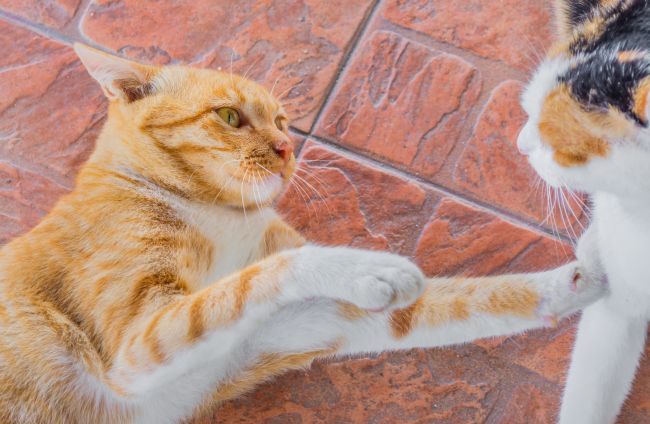
Cats love to play, wrestle, paw and chase each other around. However, they also like to nip, scratch and fight! A recent study in 2008 by the American Pet Products Association showed that most American households have 2.5 cats. That means if you are a pet owner, you are more likely to have multiple feline residents than a single one. When the cat is away the mice will play, and when there are two or more cats, there are bound to be scuffles and fights in the house. Though it may be nearly impossible to avoid ALL argumentative encounters, here are 5 quick tips you can apply to circumvent in-house cat fights.
5 Tips for Avoiding Cat Fights
Give each cat his own space. Children seem to get along better when they have boundaries over their own toys and space. Where there are no boundaries, bickering seems to occur more frequently; the same is true of cats. This means, your two cats’ perches, toys, beds, and even cat furniture should be separated for a time. One helpful way to aid the cats in identifying the objects as their own, is to leave them enclosed with the bed, blanket, or cat tree in the utility room, garage or laundry room for a day or two. This will help them recognize the item as their own, making them feel secure. (Make sure to keep food, water and litter boxes handy for your cats as they grow accustomed to the new space!)
Feed them separately: When tummies are growling, it can be easy for cats to compete for the larger portion. Avoid face-scratching squabbles by setting out one cat dish in the kitchen and the other in the laundry room. Feeding both cats separately can help your pets feel unthreatened and able to eat in peace, so that when they are reunited, they will be more relaxed and less inclined to fight.
Stay scent-aware: If you separate the cats for whatever reason (a trip to the veterinarian’s for example) and bring one cat home after an outing, the second cat might behave defensively or strangely. This is simply because the vet-visiting cat picks up new and foreign smells from the other animals at the clinic, and from the vet herself. Before bringing the cats back together, wipe your cat’s coat with a towel from your home (laundry room/cat bed/kitchen) and rub down his back, head and legs to “remove” any unfamiliar odor. Better yet: give each cat his own towel to keep in his cat bed. Then when the cats are separated, wipe one cat’s towel on the other to help promote familiarity and positive associations between them.
Avoid external fight triggers: One common behavior among cats is to sit at the window and watch passers-by. Seeing a bird or nearby squirrel can agitate an on-looking cat who is unable to chase this prospective prey. Looking to release his frustration, the cat might leap for your other pet, causing domestic hell to break loose. If you notice one kitty acts out after every window-watching interlude, keep the shades shut, or the cats in a different room.
Break it up: If the battle has already begun, and you want to stop the cat fight, do not get involved physically, or you may wind up with a scratch. First shout and clap loudly to get their attention. Usually this will cause the cats to leap away from each other in search of a hiding place. However, if this tactic proves ineffective, throw a blanket or pillow in their midst to break up the fight, or spray a bottle of water in their faces to make them stop. On particularly aggressive occasions, it is best to separate the cats for a time until they cool off. In any case, remember that you are the boss, and it is your job to remain in control of your recalcitrant kitties, whenever they are looking for a fight. Help set them up for success by following these simple steps.

